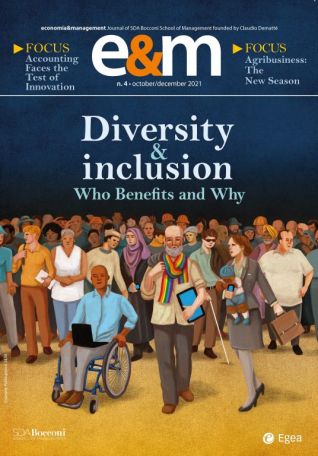E&M
2021/4
Between Vision and Organization: The Teaching of Social Movements
Although with different demands and goals, Greenpeace and Occupy Wall Street are both expressions of social movements. While Greenpeace has transformed from a pacifist movement into a very structured and prominent multinational environmental organization, OWS, despite its large media impact and rapid global spread – had a relatively short life. The examples of Greenpeace and OWS are useful to understand the different paths of growth – and the related limits – when a decision is made to move from an initial phase as a "simple" flexible and destructured movement to a subsequent phase marked by greater presence and organizational structure. This is a reflection that regards businesses as well.
Various anniversaries fall in this period (September 2021). Even though the most immediate for most of us is unquestionably the twenty-year anniversary of the attack on the Twin Towers (9-11), I would like to focus on two lesser known, but in any event significant events: fifty years since the birth of Greenpeace, and ten years of Occupy Wall Street (OWS). Although with different demands and goals, Greenpeace and Occupy Wall Street are both expressions of social movements. Yet while Greenpeace has transformed from a pacifist movement into a very structured and prominent multinational environmental organization, OWS, despite its large media impact and rapid global spread – had a relatively short life. An analysis of the two paths of growth allows us not only to understand the different outcomes, but also to extend the reflection to other fields and organizations.
Greenpeace was born in Vancouver in 1971, as the expression of two distinct components: the pacifist side (peace) that opposed the Cold War and the Vietnam War (that found a direct expression among American conscientious objectors who took refuge in Canada to avoid the draft), and the environmentalist side (green) that sought to defend and preserve the environment from destruction by man. The founding event was the common protest action against the decision by the United States to detonate a nuclear warhead in a remote area of Alaska. After this initial joint experience, that would also continue in similar contexts (for example against the French nuclear tests in Polynesia), it would be the environmentalist component, though, with its campaigns against the massacre of whales or seals for commercial purposes, that would become prevalent and dictate the agenda and future direction of the organization, that in the meantime grew and spread internationally through separate local organizations without central control.
For a social movement, growth is a very important goal per se, regardless of how spontaneous, chaotic, or unguided it may be: aggregate and mobilize as many people as possible so as to spread the message and generate pressure to reach the goals set. But after this initial phase, sooner or later it becomes necessary to introduce some structural elements within the movement. Like in a creek that swells and brings together various tributaries, it becomes essential to control the flow. When intervening though, it is very important not to interrupt the flow or dry up the basin. It is essential to understand if the structural components are more similar to banks, that do not stop the movement, or dykes that block it entirely, while also remembering that even in the first case, something is lost forever.
Greenpeace also went through this phase, and decided that at a certain point some sort of organizational structure was necessary. As recalled by those who witnessed that period, the people who design and manage those structures are not the same type of people who say "let's put our boat in front of a whaleboat." They think in a completely different way.[1] To use an academic term, we could say that Greenpeace – despite going against existing institutions with positions and actions that are often conflictual, not cooperative – has gradually been "institutionalized." From a movement it became an organization, without this having damaged its impact and success.
The path followed by OWS was in part different. In this case as well, it was a movement whose mind and initial thrust came from Vancouver, the home of Adbusters, a magazine critical of capitalism and consumerism that, after a series of campaigns such as Buy Nothing Day or TV Turnoff Week, proposed occupying Wall Street. The initiative, following the 2008 financial crisis and the ensuing global economic recession and the effects it produced, was successful, and in September 2011, the occupation of a park near the global symbol of international finance began. The occupation would end with the clearance of the park by police after about two months, but despite the short life, the movement had a notable impact in the media and would become a model for similar occupations that simultaneously spread in other cities of the United States and the world.
In a manner similar to Greenpeace, there was intense, spontaneous growth, without central control. Yet there is an important difference: it was (intentionally) not clear what goal was to be pursued through the protest. In the case of Greenpeace there were specific goals both immediately (stop a nuclear test or prevent whaling ships from operating) and medium to long-term goals (a moratorium on nuclear tests or commercial whaling). In the case of OWS a single goal seemed to exist – to occupy a symbolic place – that went from being a means to an end. This perspective was evident from the time of the famous first poster that called for the occupation and depicted the bull sculpture on Wall Street with a ballerina balanced on top and demonstrators who emerge from a cloud of tear gas below. In red letters it said: "What is our one demand?" Below was the hashtag #OccupyWallStreet and the imperative "BRING TENT."
As some participants recall, "we didn't have demands, but we had a vision."[2] It was a vision of direct democracy, mass participation, and decision-making that was horizontal, undeniably anarchic, but able to attract common people. The target of the moment was in fact common people, with the famous slogan "we are the 99%," addressed to all of those who felt abandoned and betrayed by the myth of capitalism founded on increasing well-being for everyone and not only limited, as in actual fact, to a small minority that continues to be enriched. It would be this broad vision, without a specific demand, that attracted many: from anarchic groups to accomplished activists, from debt-burdened students to workers who had lost their job or retirees who had been evicted from their homes because they couldn't pay the mortgage. A too-limited objective would have damaged the growth and spread of the movement, but at the same time it was exposed to the danger of coming apart in a short period of time.
For many, OWS was in fact considered a failure, an episode that allowed many people to demonstrate their indignation for a short period of time and then return to their homes without having reached a result. For others, despite its short life, OWS left a great legacy.[3] Even though it did not materially change the world, the movement had the courage to openly say that the king (current capitalism) had no clothes. That is, it created a debate on inequality that spread and found an echo in cultural areas (for example, think of the success of Thomas Piketty's book Capital in the 21st Century) and in the political world, with the rise of Bernie Sanders in the United States, a country in which the word socialism had been practically extinct, or of movements such as the Indignados in Spain, or in part, the 5-Start Movement in Italy. This view holds that the end of the occupation of Wall Street with the clearance of the streets did not mark the end of the movement. As stressed by the participants themselves, "You cannot evict an idea."
The examples of Greenpeace and OWS are useful to understand the different paths of growth – and the related limits – when a decision is made to move from an initial phase as a "simple" flexible and destructured movement to a subsequent phase marked by greater presence and organizational structure. This is not a reflection limited to only the area of social movements, but it regards businesses as well. In recent decades, various companies – think of numerous Silicon Valley start-ups – have adopted many of the characteristics that distinguish social movements: participatory processes involving assemblies, transparent communication, predominantly horizontal organizational structures, workplaces traditionally assigned a limited function (work activities) that, during the temporary occupation of schools or public areas, became a stable office for all of the other activities people do (recreation, dormitory, gym, restaurants, etc.).
In these businesses it is often growth itself, even if disorderly and convulsive and apparently detached from economic logic, that is the main goal. Think of examples such as Facebook or Google or Amazon, joined together by the same strategy: "Be first to market, grow like crazy, and figure out the money later."[4] This is a logic very similar to that of OWS: first we worry about occupying a space, attracting and involving the largest number of people, and then we will think of how to channel this occupation towards goals that translate into results. As with social movements, for this type of business the moment comes, though, to figure out if, when, and how to transform from a "movement" into an "organization" aware of the limits and risks of that step. If taken too early or done poorly, there is in fact the risk of losing the support of consumers and workers and thus interrupting growth. If done too late, the risk is not succeeding in translating growth into tangible results. Although with evident differences, cases like that of Greenpeace and OWS can thus be useful examples on which to reflect.
In the month of September 2021, in addition to those of Greenpeace and OWS, there is another anniversary that I would like to recall: fifty years of the SDA Bocconi, the Bocconi's business management school, to which this magazine is directly linked. This is an important achievement for an institution that has many traits in common with the social movements that I have described above, and that was created by a group of visionaries led by Claudio Dematté, with a position that challenges even the same university in which it was born, and with respect to which it has always sought to maintain and preserve distinction and independence. SDA Bocconi has also been transformed over time; it has grown and gradually become more organization and less movement. The legacy of that initial spirit is still alive and present, and I hope that it always remains a part of the School and its magazine in the future.
The dossier of this number is dedicated to diversity and inclusion. In this case as well, these are issues brought to the attention of society and businesses thanks to the struggles and actions of different social movements. The articles that make up the dossier, with a broad perspective and depth of analysis, help us understand the complexity of the issue and the challenges that still await us.
Enjoy reading!
The quote is contained in Jerry Rothwell's documentary on the history of Greenpeace: "How to Change the World. The Revolution Will Not Be Organized," 2015.
The quote is contained in Marisa Holmes' documentary on OWS: "All Day All Week: An Occupy Wall Street Story," 2016.
See the articles by M. Levitin, "Occupy Wall Street Did More Than You Think", The Atlantic, September 14, 2021; and D. Loucaides, "Did Occupy Wall Street mean anything at all?", Financial Times, September 17, 2021.
As illustrated also by recent books on Facebook (S. Frenkel, C. Kang, An Ugly Truth, London, The Bridge Street Press, 2021) and Amazon (B. Stone, Amazon Unbound, London, Simon&Schuster, 2021).




